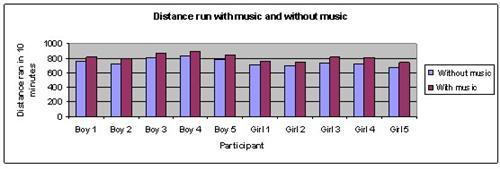| Complexity level: | 7 |
| Project cost ($): | 10 |
| Time required: | 1 hour to prepare, 2 days for experiment |
| Material availability: | Easily found |
| Safety concerns: | None |
Hypothesis
An athlete who listens to music will be able to run faster and farther than one who doesn't listen to music whilst exercising.
Overview
Effect of music on athletic performance
Music helps people in a variety of ways. Apart from being a form of entertainment, it is also a good motivational and relaxation tool. However, one of the most significant uses of music is in exercise. Music can help to make exercise more enjoyable and tolerable. It can also help to improve a person’s athletic performance.
Music helps athletes to be distracted from the pain and fatigue when they exercise and therefore it helps to perform better. When an athlete focuses on music, he becomes subconsciously distracted from the fatigue..
However, recent studies suggest that music serves as more than just a distraction. Music can help to affect the mood of an athlete. Listening to lively music for example, can psyche up an athlete and motivate him to increase the intensity of his training. Slow paced songs can help to relax an athlete before working out or competing.
Music also helps to synchronize the rhythm of body movements and can help our muscles in lthe earning of new motions/movement.
Scientific Terms
Materials
The materials required for the experiment:
- 5 boys and 5 girls aged 16 years of age
- A treadmill
- A stopwatch
- MP3 player with earphones. Fast paced songs are uploaded into the MP3.
Procedure
1. For this experiment, the independent variable is whether the participant is listening to the music. The dependent variable is the distance ran by the participant on the treadmill within the specified time. The distance ran by the participant is indicated on the treadmill display. The constants (control variables) are the age of the participants, the time given to the participants to familiarize themselves with the treadmill and the fixed time given for participants to run on the treadmill.
2. Five boys and five girls aged 16 years old are selected to take part in this experiment. The participant must be physically fit and must not have any health problems.
3. On the 1st day of experiment, the 5 boys and 5 girls are brought into the gym and made to warm up for 5 minutes. No music is used on this 1st day of the experiment. After the warm up, the 1st participant is given 5 minutes to run on the treadmill to familiarize himself with the equipment. The participant is then made to run on the treadmill for 10 minutes. The time is monitored using the stopwatch. The distance the participant ran on the treadmill for the 10 minutes is recorded in the table given below. The remaining 9 participants are made to go through the same process.
4. On the 2nd day of the experiment, the 5 boys and 5 girls are again brought into the gym and made to warm up. They are again given 5 minutes to familiarize themselves with the treadmill .This time, as they run on the treadmill for 10 minutes, they are made to listen to some fast paced songs on the MP3. The time is monitored using the stopwatch. The distance each participant ran on the treadmill is recorded in the table given below.


Results
The results show that the participants were able to run longer distances when listening to lively music.

The graph below represents the results of our experiment.

Conclusion
The hypothesis that participants listening to music during exercise will be able to run faster and farther than the participants who are listening to music, is proven to be true.
Having music in the background makes time see to pass more quickly and it distracts us from pain and fatigue. Therefore, music can be an effective tool in training an athlete’s stamina, confidence and performance.
Also consider
The experiment can also be done by using slow or classical music to determine if the results will differ.
This experiment can also be repeated on other kinds of sports like cycling.
References
The effects of music on athletic performance - http://serendip.brynmawr.edu/exchange/node/2474
Music, not steroids: enhance your athletic performance - http://rumblefish.com/blog/2007/09/07/goulds-blog-part-deux/

